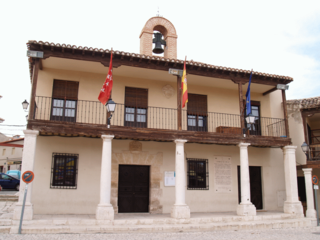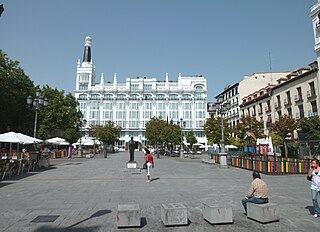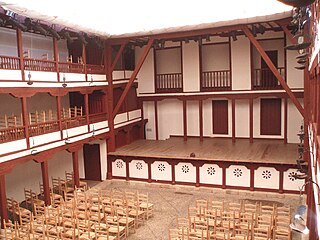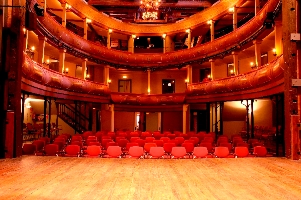
Pedro Calderón de la Barca y Barreda González de Henao Ruiz de Blasco y Riaño, usually referred as Pedro Calderón de la Barca, was a dramatist, poet and writer of the Spanish Golden Age. During certain periods of his life he was also a soldier and a Roman Catholic priest. Born when the Spanish Golden Age theatre was being defined by Lope de Vega, he developed it further, his work being regarded as the culmination of the Spanish Baroque theatre. As such, he is regarded as one of Spain's foremost dramatists and one of the finest playwrights of world literature.

Life Is a Dream is a Spanish-language play by Pedro Calderón de la Barca. First published in 1635 during the Spanish Baroque period (NADV1), it is a philosophical allegory regarding the human situation and the mystery of life. The play has been described as "the supreme example of Spanish Golden Age drama". The story focuses on the fictional Segismundo, Prince of Poland, who has been imprisoned in a tower by his father, King Basilio, following a dire prophecy that the prince would bring disaster to the country and death to the King. Basilio briefly frees Segismundo, but when the prince goes on a rampage, the king imprisons him again, persuading him that it was all a dream.
José de Cañizares y Suárez was a Spanish playwright. Cavalry officer, public official, and author of around one hundred works, he was one of the most important dramatists of the early 18th century.

Almagro is a town and municipality situated in Ciudad Real province, in the autonomous community of Castile-La Mancha, Spain. A tourist destination, Almagro is designated a Conjunto histórico, a type of conservation area.
A loa is a short theatrical piece, a prologue, written to introduce plays of the Spanish Golden Age or Siglo de Oro during the 16th and 17th centuries. These plays included comedias and autos sacramentales. The main purposes for the loa included initially capturing the interest of the audience, pleading for their attention throughout the play, and setting the mood for the rest of the performance. This Spanish prologue is specifically characterized by praise and laudatory language for various people and places, often the royal court for example, to introduce the full-length play. The loa was also popular with Latin American or "New World" playwrights during the 17th and 18th centuries through Spanish colonization.
Juan Hidalgo de Polanco was a Spanish composer and harpist who became the most influential composer of his time in the Hispanic world writing the music for the first two operas created in Spanish. He is considered by many to be the father of Spanish Opera and of the Zarzuela
Pedro de Candia was a Greek explorer and cartographer at the service of the Kingdom of Spain, an officer of the Royal Spanish Navy that under the Spanish Crown became a Conquistador, Grandee of Spain, Commander of the Royal Spanish Fleet of the Southern Sea, Colonial Ordinance of Cusco, and then Mayor of Lima between 1534 and 1535. Specialized in the use of firearms and artillery, he was one of the earliers explorers of Panama and the Pacific coastline of Colombia, and finally participated in the conquest of Peru. He was killed in the Battle of Chupas, (Peru), on 16 September 1542, by Diego de Almagro II.
Frederick A. de Armas is a literary scholar, critic and novelist who is currently Andrew W. Mellon Distinguished Service Professor in Humanities at the University of Chicago.

Colmenar de Oreja is a town and municipality of the Las Vegas comarca, in the Community of Madrid, Spain. It was subject to a seven-month siege in 1139.

Plaza de Santa Ana is a plaza located in central Madrid, Spain, nearby Puerta del Sol and Calle de Huertas, in the Barrio de las Letras. It features monuments to Spanish Golden Age writer Pedro Calderón de la Barca and the Granadian poet Federico García Lorca and numerous restaurants, cafes and tapas bars, with its terraces covering most of the sides surfaces.

Spanish Golden Age theatre refers to theatre in Spain roughly between 1590 and 1681. Spain emerged as a European power after it was unified by the marriage of Ferdinand II of Aragon and Isabella I of Castile in 1469 and then claimed for Christianity at the Siege of Granada in 1492. The sixteenth and seventeenth centuries saw a monumental increase in the production of live theatre as well as the in importance of the arts within Spanish society.

The Teatro Calderón de la Barca is a theater in Valladolid, Spain. It is named after the playwright Pedro Calderón de la Barca.

Teatro Español is a public theater administered by the Government of Madrid, Spain. The prime location was an open-air theater in medieval times where small venues and some theatrical pieces, which formed famous classical literature in later years, were staged. Its establishment was authorized by a decree of Philip II in 1565.

Corral de comedias, literally a "theatrical courtyard", is a type of open-air theatre specific to Spain. In Spanish all secular plays were called comedias, which embraced three genres: tragedy, drama, and comedy itself. During the Spanish Golden Age, corrals became popular sites for theatrical presentations in the early 16th century, when the theater took on a special importance in the country. The performance was held in the afternoon and lasted two to three hours, there being no intermission, and few breaks. The entertainment was continuous, including complete shows with parts sung and danced. All spectators were placed according to their sex and social status.

Corral de Comedias de Alcalá de Henares in Alcalá de Henares, Community of Madrid, Spain, is one of the oldest preserved theatres in Europe. Built in 1601-02 and designed to mirror the Corral de la Cruz in Madrid, the architect was Francisco Sánchez.
Plaza Mayor de Almagro is a town square located in the city of Almagro, Castile-La Mancha, Spain. Amalgro is designated a conjunto histórico, and the square is of architectural interest. It is the location of the city hall and a historic theatre, the Corral de comedias de Almagro. Amalgro is a name of Arabic origin referring to the local red clay, which is one of the materials used in the plaza mayor. Probably the settlement began as a small Muslim castle, possibly on the site now occupied by the hermitage of San Juan. The fief was bestowed on Gonzalo Yáñez de Noboa, ninth Grand Master of the Order of Calatrava, after the Battle of the Navas de Tolosa, and the grant was confirmed by Ferdinand III in 1222. Amalgro became an important centre for the Order of Calatrava and the area which became known as Campo de Calatrava.
Campo de Calatrava is a comarca in Castilla-La Mancha, Spain. It takes its name from the Order of Calatrava, a military order which held territory in the area from the time when it was on the border between Christian and Muslim Spain.

The Teatro Rojas is a theater in the city of Toledo. It was inaugurated in 1879 on the old corral de comedias called Mesón de la Fruta and in its construction participated several architects. It is denominated like this in honor of the Toledan playwrighter Francisco de Rojas.
The Festival of Spanish Theatre of London (FesTeLõn) has taken place in June every year since 2013, when it opened at the Greenwood Theatre, with a production of El Diccionario by Manuel Calzada, a play about the lexicographer María Moliner, with Vicky Peña starring in the lead role. Its objective is to bring contemporary theatre beyond the borders of Spain, working with professional Spanish theatre companies. The plays are usually performed in Spanish with English surtitles in order to ensure that they are accessible to the widest possible audience. The festival also includes a full programme of related talks and workshops to complement the stage performances, as well as bilingual “meet the cast” sessions, with Q&A.














